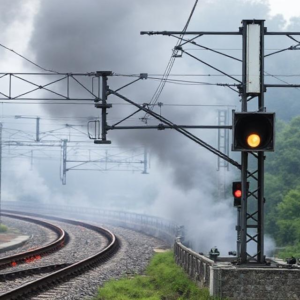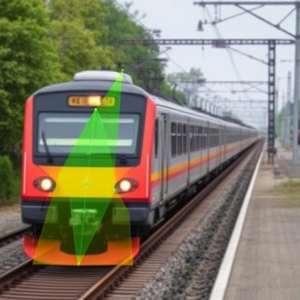GPS-based Train Tracking Systems are technologies used to track the real-time location of trains using the Global Positioning System (GPS). This system helps railway operators, authorities, and even passengers know exactly where a train is at any given moment. Let’s break this down in an easy way!
1. What is a GPS-based Train Tracking System?
- GPS (Global Positioning System) is a satellite-based system that provides location information anywhere on Earth.
- A GPS-based Train Tracking System uses this GPS technology to track and display the location of trains in real time.
- This system helps railway operators monitor trains, improve safety, and inform passengers about train arrivals and delays.
![]()
2. How Does a GPS-based Train Tracking System Work?
Here’s how it works in simple steps:
a) GPS Receiver on the Train:
- Each train is equipped with a GPS receiver (a device that picks up signals from GPS satellites).
- These GPS receivers are placed on the train (usually in the locomotive or at strategic points on the train) to track its exact location.
b) Receiving Signals from Satellites:
- The GPS receiver communicates with multiple GPS satellites orbiting the Earth. These satellites send signals to the receiver, telling it exactly where the train is in terms of latitude, longitude, and elevation.
- Using signals from at least three or four satellites, the GPS system calculates the train’s precise position on Earth.
c) Sending Data to the Control Center:
- The location data (latitude, longitude, speed, and direction) from the GPS receiver is sent to a central control center through wireless communication methods, such as cellular networks or satellite communication.
- This data is continuously updated and transmitted in real time.
d) Displaying Train Location:
- At the central control center, operators can see the real-time location of all trains on a map or dashboard. This allows them to monitor and manage train movements efficiently.
- The information is also shared with passengers through apps, websites, or digital displays at stations, showing them the train’s location, expected arrival time, and any delays.
3. What Information Does the GPS-based System Provide?
A GPS-based Train Tracking System provides several important pieces of information:
- Real-time Train Location: Shows exactly where the train is on the map. This helps operators manage train schedules, avoid collisions, and ensure safe operations.
- Train Speed: Tracks how fast the train is moving. This information helps operators monitor train performance and safety.
- Train Direction: It shows the direction in which the train is heading, so operators can ensure the train is on the right track.
- Arrival Times and Delays: The system calculates the estimated arrival times of trains at stations. If a train is delayed, the system can update passengers with the new expected time of arrival.
4. Benefits of GPS-based Train Tracking Systems:
Here’s how GPS tracking helps make railways safer, more efficient, and passenger-friendly:
a) Improved Safety:
- GPS tracking helps prevent accidents by giving operators real-time updates on train locations, making sure trains don’t get too close to each other.
- In case of emergencies, knowing the exact location of a train allows quick response actions, such as sending rescue teams or stopping the train if needed.
b) Better Train Management:
- With GPS tracking, operators can see all trains in real time, making it easier to manage and control train schedules.
- This helps in avoiding congestion, delays, and track conflicts, as operators can adjust schedules based on the current positions of trains.
c) Accurate Information for Passengers:
- Passengers benefit by getting accurate and real-time updates about train locations and arrival times. This reduces the frustration of waiting for a train without knowing when it will arrive.
- Apps or station displays give passengers estimated times of arrival, helping them plan their travel better.
d) Optimized Routes:
- GPS tracking can be used to help optimize train routes, reducing unnecessary stops or detours. It can help trains take the most efficient paths, saving time and fuel.
e) Real-time Monitoring and Alerts:
- Operators can monitor train performance and receive alerts if something goes wrong (like if a train is moving too fast, off track, or deviating from its route). This allows them to respond quickly and avoid accidents or delays.
f) Increased Efficiency and Punctuality:
- GPS helps in better management of train schedules. By constantly monitoring train positions, operators can make adjustments to ensure trains stay on time.
- This also helps in preventing overcrowding at stations, as operators can direct trains more efficiently.
5. Applications of GPS-based Train Tracking Systems:
a) Passenger Convenience:
- Passengers can track trains using mobile apps or websites. They get real-time updates on train status, delays, and arrivals, making their travel experience much more convenient.
b) Fleet Management:
- Railways can manage their entire fleet of trains efficiently. GPS helps operators track where each train is, how fast it is moving, and whether it’s on time or delayed.
c) Maintenance and Monitoring:
- Operators can use the GPS data to monitor trains for any unusual behaviors, such as speeding, braking too hard, or taking too long to reach certain points. This helps in identifying issues early and scheduling maintenance or repairs.
d) Cargo Tracking:
- GPS-based systems are also used for tracking freight trains. It allows operators and customers to know the exact location of cargo shipments, ensuring timely deliveries and better logistics management.
6. Challenges in GPS-based Train Tracking Systems:
While GPS tracking offers many benefits, there are a few challenges:
a) Signal Interference:
- In some areas, such as tunnels or remote locations, GPS signals can be weak or blocked. This might cause delays in tracking the train’s exact location.
b) Cost of Implementation:
- Installing GPS devices and setting up tracking systems for an entire railway network can be expensive for rail operators.
c) Reliability of Communication:
- For the GPS data to be useful, it needs to be transmitted reliably to the central control center. If the communication network is down (due to technical issues or bad weather), real-time tracking might be disrupted.
d) Data Overload:
- With many trains running on a network, the system can generate a lot of data. Managing and analyzing this data efficiently requires advanced software and systems, which can be complex to set up.
7. Future of GPS-based Train Tracking Systems:
- Integration with Smart Technologies: Future systems may integrate GPS with other technologies like IoT (Internet of Things) sensors, AI (Artificial Intelligence), and big data to improve the tracking, performance monitoring, and predictive maintenance of trains.
- Autonomous Trains: GPS technology is also a key part of making autonomous trains possible. As trains become more automated, GPS systems will play a major role in guiding the trains safely along their routes.
- 5G Networks: With the arrival of 5G, GPS-based systems will become even more reliable and faster, providing real-time data with minimal delays. This will improve the overall efficiency of the system.
Conclusion:
GPS-based Train Tracking Systems are vital for modern railways. They provide real-time information about train locations, speed, and direction, helping operators improve safety, efficiency, and punctuality. Passengers also benefit by receiving accurate updates about their train’s arrival times and delays. Though there are some challenges, the system’s ability to manage and monitor trains effectively makes it an essential tool for modern rail transport.
Keywords: GPS-based Train Tracking Systems, Railway











